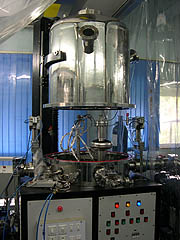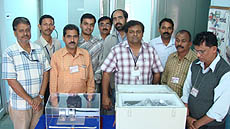RRCAT laser-welded cavity shows promise
 |
RRCAT scientists used this specially created welding rig in making a laser-welded SRF cavity. Photo courtesy of Prashant Khare / RRCAT
|
Engineers at the Raja Ramanna Centre for Advanced Technology in India recently partnered with Fermilab to test the product of their unique laser welding process, which could eventually reduce the cost and time required to weld niobium accelerator cavities.
SRF cavities, which make up the core of modern accelerators, are typically made with niobium, an exotic metal with a high melting point and other sensitivities that prevent engineers from welding it using conventional methods. Most laboratories fabricate niobium cavities using electron beam welding machines, which must operate in a vacuum.
"The maintenance and operation for electron beam welding machines are expensive," said Fermilab engineer Chuck Grimm, who is a main point of contact for the RRCAT team. "But they produce very good, very consistent results."
A group led by engineer Prashant Khare, head of the cryomodule engineering laboratory at RRCAT, an Indian Department of Atomic Energy laboratory, successfully fabricated a 1.3-gigahertz, single-cell cavity using a laser and no vacuum, only a stream of ultra-pure argon gas to keep the molten niobium from becoming oxidized.
RRCAT laser physicist Brahmand Upadhyay led a team that developed the laser, and an Indian industrial partner developed a special welding rig for the project.
Producing laser-welded SRF cavities could reduce the cost of cavity fabrication for future accelerator projects, such as a free-electron laser or a new proton accelerator, Grimm said. The fact that Fermilab has worked with RRCAT on accelerator R&D projects for the past six years and the availability of the necessary expertise and infrastructure made Fermilab the obvious location to test the cavity.
"Fermilab has been very supportive of all projects related to SRF," Khare said. "Even if an idea is new and unconventional, they accept it. They say, 'Let's give it a try.'"
The Indian Institutions – Fermilab Collaboration (IIFC) is developing a similar testing infrastructure, which is scheduled to be operational in the near future, at RRCAT.
The cavity, along with RRCAT engineer Rupul Ghosh, arrived at Fermilab in July. Khare followed in August. He witnessed a preliminary test, in which engineers ramped up a current in the cavity to see how much it could handle.
"The accelerator gradient was going up," he said. "Our heart rates were also going up. I could see the happiness on everyone's faces."
The single-cell cavity achieved a highly commendable score, with an accelerating gradient of 17 megavolts per meter and a quality factor of 1.4x1010.
"It takes a while to refine everything, to get the parameters set up and to have reproducibility," Grimm said. "So I am very impressed with the way their first cavity turned out."
After the first test, Ghosh, Fermilab engineer Allan Rowe and Rowe's team put the cavity through polishing and baking processes to remove impurities. Scientists and engineers on both sides of the Pacific were thrilled by the second set of results: an accelerating gradient of 31 megavolts per meter and a quality factor of 1x1010. A nine-cell cavity receiving such a score would qualify to be used in proposed future accelerators, including a high-intensity proton accelerator at Fermilab.
—Kathryn Jepsen
 |
These RRCAT scientists were involved in making the 1.3-gigahertz single-cell cavity. Photo courtesy of Prashant Khare / RRCAT
|
|